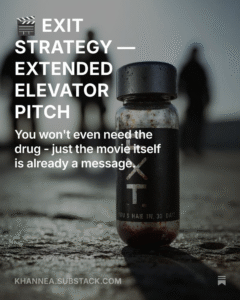NOTICE: This is a site of speculative fiction and strategic foresight.
|All content is intended as narrative exploration, not advocacy, instruction, or prediction.
No endorsement of violence, sedition, or illegal acts is made or implied.
|This work is protected under artistic and academic freedom.
By Celeste Marten, Culture & Security Correspondent, The Atlantic
March 11, 2028
“You don’t understand,” the man told police as they pulled him from the shattered lobby of a Dallas law firm.
“I didn’t want to live. But I needed them to hear me. EXIT gave me the script.”He wasn’t on drugs. He had no criminal record.
He had a Blu-ray of a film that was never legally released in the United States.
When EXIT STRATEGY was quietly uploaded to a Romanian file-sharing site in early 2026, it was dismissed by most critics as art-house LARPing. A low-budget European horror film, shot without permits in protest zones and abandoned courthouses, stitched together with masked monologues, grainy protest footage, and a bleak fatalism that felt more like a manifesto than a screenplay.
No known distributor. No credits. No funding source. No official statement from its supposed creators.
The only name publicly attached to it was that of a Dutch writer: Khannea Sun’Tzu, known only for a Substack post months before the film’s release titled “EXIT STRATEGY: An Elevator Pitch in Two Parts.”
The film depicted a fictional injectable drug, EXIT, which removed the user’s survival instinct. But there was no drug. No evidence of synthesis. Nothing real except the idea.
And that was enough.
“Not a Film. A Protocol.”
By late 2026, EXIT STRATEGY was circulating widely underground. Torrent sites. Burner USBs. Student forums. Militias. Prisons. The film became something new: a ritual script for acts of vengeance performed not out of frenzy—but of purpose. EXIT wasn’t a call to arms. It was a call to endings.
Social workers in Tulsa began reporting clients repeating lines from the film verbatim. A Mississippi pastor was recorded quoting an EXIT monologue before immolating himself on the steps of a for-profit prison. A New York subway shooter left behind a manifesto simply stating:
“I was Exit. I chose how. So will you.”
By mid-2027, at least 22 violent incidents across four countries were linked directly or indirectly to the film. None of the perpetrators had histories of extremist ideology. Many were terminally ill. Some were just… hopeless. The Department of Homeland Security quietly classified the film as a “narrative terror vector.” A leaked memo described it as:
“a memetic contagion leveraging cinematic realism to destabilize moral thresholds.”
They weren’t wrong.
The Government Reaction
In late 2027, after a former ICE contractor was executed live on camera by a masked woman who recited a 72-second passage from the film word-for-word, the Senate held an emergency closed-door session. One unnamed aide reportedly told journalists:
“This isn’t terrorism. It’s existential theater. And we can’t arrest a movie.”
Meanwhile, schools began banning access to the film. Universities revoked thesis projects related to it. Mental health professionals were instructed by federal agencies to “monitor for Exit-aligned narrative delusions.” A short-lived therapy directive labeled “Narrative Dissociation Syndrome” emerged—promptly mocked online. And yet… the film continued to spread.
The A-Listers Behind the Masks
In 2028, forensic voice-matching confirmed what many had suspected: at least three well-known actors—two American, one French—had appeared in the film in masked, uncredited roles. One had since vanished from public life. Another, after being doxxed, released a single statement:
“I believed in the project. I still do. Art is not terror.”
Their careers effectively ended. But to many viewers, their sacrifice only proved the film’s thesis: that fear of consequence is the final leash—and EXIT cuts it clean.
Final Impact
As of this writing, EXIT STRATEGY has been formally banned in 17 countries, including the United States. Possession is considered grounds for “enhanced psychological screening” in several states. Viewing parties are classified as potential radicalization events by Interpol. And yet—every month, new edits, dubbed versions, and AI-enhanced remixes circulate. The drug was never real. But the script was. And apparently, that was enough.
“This was never about drugs,” one anonymous filmmaker said in a posthumous interview released after his suicide.
“It was about permission.The film didn’t give it.
It just reminded us we don’t need to ask.”
